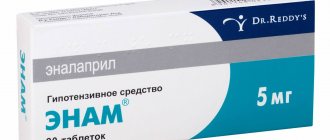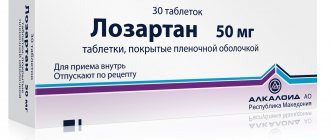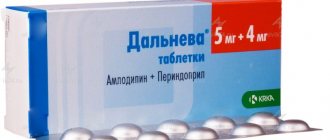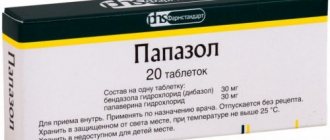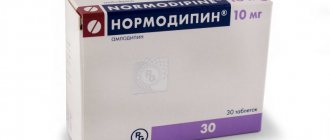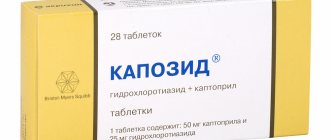High blood pressure requires drug treatment. Tablets for the treatment of hypertension are prescribed by the attending physician. The most effective drugs for lowering blood pressure are combination tablets, which contain several active substances at once. These medications include blood pressure tablets Co-Renitek. The drug contains the components of an ACE inhibitor and a diuretic, comprehensively lowering blood pressure and having a beneficial effect on the vascular system, heart, and myocardium. You must take the pills with your doctor's permission.
Pharmacodynamics and pharmacokinetics
This drug reduces the level of sodium ions in the vascular wall, blood pressure , arterial vascular tone, peripheral , and also increases diuresis . The hypotensive effect lasts throughout the day.
Thus, the drug is effective in cases of arterial hypertension . The hypotensive effect of the active components of the drug complements each other. Therapy with this drug is more effective in most cases for arterial hypertension than the use of enalapril maleate and hydrochlorothiazide separately.
Enalapril is an ACE inhibitor . Once absorbed it is metabolized to enalaprilat . Its action leads to a decrease in the level of angiotensin II in plasma, which increases the activity renin and decreases the secretion of aldosterone . In addition, enalapril prevents the destruction of bradykinin .
The decrease in blood pressure is accompanied by a decrease in total peripheral vascular resistance and a slight increase in cardiac output. The drug increases renal blood flow . the glomerular filtration rate does not change , unless it was initially reduced in patients.
Hydrochlorothiazide is a diuretic and antihypertensive agent that helps increase renin . Thus, when combined with enalapril , it results in a greater reduction in blood pressure . Discontinuation of the drug does not cause its sharp increase.
The maximum effect, as a rule, appears 2-4 hours after application. The hypotensive effect is noticeable within an hour. The duration of action of the medicine largely depends on the dosage. As a rule, it lasts throughout the day.
special instructions
Due to the fact that symptomatic hypertension may develop during therapy, it is necessary to examine patients to identify clinical signs of fluid and electrolyte imbalance, which may occur due to episodes of diarrhea or vomiting. Blood electrolyte composition should be determined in such patients at certain intervals during treatment.
The drug is prescribed with extreme caution for cerebrovascular diseases or ischemic heart disease, because An excessive decrease in blood pressure (BP) can lead to the development of stroke or myocardial infarction.
In cases of arterial hypotension, bed rest and, if necessary, intravenous administration of saline are indicated. Transient arterial hypotension is not a contraindication to further use of the drug. After normalization of blood volume and blood pressure, treatment can be resumed in slightly reduced doses, or each of the components of Ko-Renitek can be used separately.
Before starting therapy, in some patients without any evidence of kidney disease, when using enalapril in combination with a diuretic, there was usually a slight and transient increase in serum creatinine and blood urea. In such cases, drug therapy should be discontinued. In the future, treatment can be resumed in reduced doses, or each of the components of the drug is prescribed separately.
ACE inhibitors, like all drugs that have a vasodilating effect, should be prescribed with caution to patients who have difficulty with the outflow of blood from the left ventricle of the heart.
In patients with progressive diseases or impaired liver function, thiazide diuretics should be used with caution, since even slight changes in water and electrolyte balance can lead to hepatic coma.
It should be taken into account that the use of thiazide diuretics can:
- Cause impaired glucose tolerance, which may require dose adjustment of hypoglycemic drugs (including insulin);
- Reduce urinary calcium excretion and cause a slight and transient increase in serum calcium. Severe hypercalcemia may indicate latent hyperparathyroidism. Before testing parathyroid function, thiazide diuretics should be discontinued;
- Cause an increase in thyroid-stimulating hormone and cholesterol, however, when taking 1 tablet of Ko-Renitek containing 0.0125 g of hydrochlorothiazide, usually such effects were either not observed or were insignificant;
- Lead to gout and/or hyperuricemia. However, enalapril contained in tablets may increase uric acid levels in the urine and thus weaken the hyperuricemic effect of hydrochlorothiazide;
- Regardless of whether patients have a history of bronchial asthma or allergic conditions, cause allergic reactions. There are reports of relapses or worsening severity of systemic lupus erythematosus.
In rare cases, during therapy with ACE inhibitors, the development of life-threatening anaphylactoid reactions was observed during hyposensitization with an allergen from the venom of Hymenoptera. To avoid such reactions, you should temporarily stop taking the ACE inhibitor before starting hyposensitization.
The use of the drug is contraindicated in patients with renal failure undergoing hemodialysis. This is due to the fact that anaphylactoid reactions have been observed in patients on dialysis using high-flow membranes and concomitantly receiving ACE inhibitors. In such patients, other classes of antihypertensive drugs or other types of dialysis membranes should be used.
Cases of cough have been reported in patients receiving treatment with ACE inhibitors. In most cases, the cough is dry, persistent and disappears after treatment. Cough associated with the use of ACE inhibitors must be taken into account in the differential diagnosis of cough.
The drug is not recommended for use in pediatrics, since the safety and effectiveness of its use in children have not been established.
Contraindications
Co-Renitec should not be used in case of hypersensitivity to its components, childhood , anuria , history of angioedema , as well as hereditary or idiopathic angioedema .
This drug is prescribed with caution for:
- bilateral renal artery stenosis ;
- coronary heart disease;
- aortic stenosis;
- severe systemic connective tissue diseases;
- diabetes mellitus;
- condition after kidney transplantation;
- a diet with limited sodium content;
- old age;
- cerebrovascular diseases;
- chronic heart failure ;
- renal failure;
- inhibition of bone marrow hematopoiesis;
- conditions accompanied by a decrease in circulating blood volume;
- liver failure;
- hyperkalemia;
- stenosis of the artery of a single kidney.
Overdose
An overdose can be determined by severe arterial hypotension, beginning approximately 6 hours after taking Co-Renitec, and stupor. When taking enalapril maleate in doses of 330 and 440 mg, the content of enalaprilat in the blood plasma is 100 and 200 times higher, respectively, than its content when using therapeutic doses.
Overdose of hydrochlorothiazide leads to symptoms due to hypokalemia, hyponatremia, hypochloremia and dehydration due to excess diuresis. If the patient has previously been treated with digitalis, the arrhythmia may worsen due to hypokalemia.
In case of overdose, Co-Renitec should be immediately discontinued and the patient should be left under the close supervision of a specialist. If the drug has been taken recently, gastric lavage is prescribed, as well as supportive and symptomatic therapy to correct arterial hypotension and water-electrolyte imbalance. There is no information on specific treatment for overdose.
In case of an overdose of enalapril maleate, saline solution should be administered intravenously, and the administration of angiotensin II is also indicated. Enalaprilat can be removed from the systemic circulation by hemodialysis.
Side effects
Negative side effects, according to research, are usually moderate in nature. They usually do not require discontinuation of therapy. Side effects may be as follows:
- respiratory system – shortness of breath, cough;
- CVS - palpitations, orthostatic effects, fainting, arterial hypotension , chest pain, tachycardia ;
- musculoskeletal system - the appearance of muscle cramps, pain in the joints;
- kidneys – development of renal failure , problems with kidney function;
- laboratory indicators – hyperglycemia , hyperkalemia , hypokalemia , hyperuricemia , decreased hematocrit and hemoglobin ;
- CNS – dizziness , increased excitability, asthenia , paresthesia , increased fatigue, drowsiness , headache , sleep disturbances ;
- digestive system - dyspepsia , diarrhea , nausea, flatulence , dry mouth, vomiting, abdominal pain, constipation , pancreatitis ;
- allergies – itching , rash;
- reproductive system – development of impotence , decreased libido;
- others – tinnitus, gout .
In addition, in rare cases, when taking the medicine, undesirable manifestations such as angioedema of the glottis, limbs, tongue, face, larynx, lips, Stevens-Johnson syndrome , intestinal Quincke's edema , hyperhidrosis .
Instructions:
Clinical and pharmacological group
01.048 (Antihypertensive drug)
Release form, composition and packaging
The tablets are yellow, round, biconvex, with a grooved edge, engraved “MSD 718” on one side and a line mark on the other.
| 1 tab. | |
| enalapril maleate | 20 mg |
| hydrochlorothiazide | 12.5 mg |
Excipients: sodium bicarbonate, aqueous lactose, corn starch, pregelatinized corn starch, yellow iron oxide dye, magnesium stearate.
7 pcs. - blisters (2) - cardboard packs. 7 pcs. - blisters (4) - cardboard packs. 56 pcs. — polyethylene bottles (1) — cardboard packs.
pharmachologic effect
A combined antihypertensive drug that contains an ACE inhibitor (enalapril maleate) and a thiazide diuretic (hydrochlorothiazide). Has antihypertensive and diuretic effects.
Enalapril is an ACE inhibitor, which catalyzes the conversion of angiotensin I into the pressor substance angiotensin II. After absorption, enalapril is converted by hydrolysis to enalaprilat, which inhibits ACE. ACE inhibition leads to a decrease in the concentration of angiotensin II in the blood plasma, which entails an increase in plasma renin activity (due to the elimination of the negative feedback reaction to changes in renin production) and a decrease in aldosterone secretion.
ACE is identical to the enzyme kininase II, so enalapril can also block the destruction of bradykinin, a peptide that has a vasodilating effect. The significance of this mechanism in the therapeutic effect of enalapril requires clarification. Although enalapril lowers blood pressure by suppressing the renin-angiotensin-aldosterone system, which plays an important role in blood pressure regulation, the drug lowers blood pressure even in patients with low-renin hypertension.
A decrease in blood pressure is accompanied by a decrease in peripheral vascular resistance, a slight increase in cardiac output and no changes or minor changes in heart rate. As a result of taking enalapril, renal blood flow increases, glomerular filtration rate remains unchanged. However, in patients with initially reduced glomerular filtration rate, its rate usually increases.
Antihypertensive therapy with enalapril leads to significant regression of left ventricular hypertrophy and preservation of left ventricular systolic function.
Enalapril therapy is accompanied by a beneficial effect on the ratio of lipoprotein fractions and no effect or a beneficial effect on the content of total cholesterol.
Taking enalapril in patients with arterial hypertension leads to a decrease in blood pressure both in a standing and lying position without a significant increase in heart rate.
Symptomatic postural hypotension is rare. In some patients, achieving optimal blood pressure reduction may require several weeks of therapy. Interruption of enalapril therapy does not cause a sharp rise in blood pressure.
Effective inhibition of ACE activity usually develops 2-4 hours after a single oral dose of enalapril. The onset of antihypertensive action occurs within 1 hour, the maximum decrease in blood pressure is observed 4-6 hours after taking the drug. The duration of action depends on the dose. However, when used in recommended doses, the antihypertensive effect and hemodynamic effects persist for 24 hours.
Hydrochlorothiazide has a diuretic and antihypertensive effect and increases renin activity. Although enalapril itself exhibits an antihypertensive effect even in patients with arterial hypertension with low renin concentrations, the concomitant use of hydrochlorothiazide in such patients leads to a more pronounced decrease in blood pressure.
Enalapril reduces the loss of potassium ions caused by the use of hydrochlorothiazide. Enalapril and hydrochlorothiazide have similar dosing regimens. Therefore, Ko-Renitek is a convenient dosage form for the joint administration of enalapril and hydrochlorothiazide.
The use of a combination of enalapril and hydrochlorothiazide leads to a more pronounced decrease in blood pressure compared to monotherapy with each drug separately and allows the antihypertensive effect of Korenitec to be maintained for at least 24 hours.
Pharmacokinetics
Enalapril
Suction
After oral administration, enalapril maleate is rapidly absorbed. Enalapril Cmax in serum is observed within 1 hour after administration. After oral administration, absorption is approximately 60%.
Eating does not affect the absorption of enalapril. The duration of absorption and hydrolysis of enalapril is similar for various recommended therapeutic doses.
After absorption, enalapril is rapidly hydrolyzed to form the active substance enalaprilat, a powerful ACE inhibitor. Cmax of enalaprilat in the blood serum is observed 3-4 hours after taking a dose of enalapril orally.
Removal
Enalapril is excreted primarily by the kidneys. The main metabolites detected in urine are enalaprilat, accounting for approximately 40% of the dose, and unchanged enalapril. There are no data on other significant metabolic pathways of enalapril, with the exception of hydrolysis to enalaprilat. The plasma concentration curve of enalaprilat has a long final phase, apparently due to its binding to ACE. In individuals with normal renal function, a stable concentration of enalaprilat is achieved on the 4th day from the start of taking enalapril. T1/2 of enalaprilat with a course of oral administration of the drug is 11 hours.
Hydrochlorothiazide
Metabolism and distribution
Not metabolized. Hydrochlorothiazide penetrates the placental barrier, but does not penetrate the BBB.
Removal
T1/2 of hydrochlorothiazide is from 5.6 to 14.8 hours. It is quickly excreted by the kidneys. At least 61% of the dose taken orally is excreted unchanged within 24 hours.
Combination of enalaprilat maleate and hydrochlorothiazide
Regular use of a combination of enalapril and hydrochlorothiazide does not affect or slightly affects the bioavailability of each component of the drug. The use of a combined tablet of the drug Ko-Renitek is bioequivalent to the simultaneous administration of its ingredients in separate dosage forms.
Dosage
The drug is prescribed orally, regardless of food intake.
For arterial hypertension, the initial dose is 1 tablet. 1 time/day If necessary, the dose can be increased to 2 tablets. 1 time/day
At the beginning of therapy with Corenitec, symptomatic arterial hypotension may develop, more often in patients with water and electrolyte imbalance due to previous treatment with diuretics. Diuretic therapy should be stopped 2-3 days before starting the use of Korenitek.
In patients with impaired renal function, thiazides may not be effective enough, and with CC ≤ 30 ml/min (i.e., with moderate to severe renal failure) they are ineffective.
With a CC of 80-30 ml/min, Ko-Renitek should be used only after preliminary selection of doses of each component.
For mild renal failure, the recommended dose of enalapril maleate taken alone is 5 mg to 10 mg.
Overdose
Symptoms: severe arterial hypotension, starting approximately 6 hours after taking the drug, and stupor. After taking enalapril maleate in doses of 330 mg and 440 mg, the concentrations of enalaprilat in the blood plasma were 100 and 200 times higher, respectively, than its concentrations at therapeutic doses.
In cases of hydrochlorothiazide overdose, the most commonly observed symptoms are those caused by hypokalemia, hypochloremia, hyponatremia, and dehydration due to excessive diuresis. If you have previously been treated with digitalis drugs, the arrhythmia may worsen due to hypokalemia.
Treatment: Ko-Renitec should be discontinued; Careful medical supervision is required. Gastric lavage is recommended if the drug has been taken recently; conducting symptomatic and supportive therapy to correct water and electrolyte imbalances and arterial hypotension. There are no data on specific therapy for overdose.
In case of an overdose of enalapril maleate, intravenous infusion of saline is recommended; the administration of angiotensin II is effective. Enalaprilat can be removed from the systemic circulation by hemodialysis.
Drug interactions
When enalapril is prescribed in combination with other antihypertensive drugs, the effect may be additive.
Potassium loss caused by thiazide diuretics is usually reduced by enalaprilat. Serum potassium concentrations usually remain within normal limits.
The use of potassium supplements, potassium-sparing diuretics, or potassium-containing salts, especially in patients with renal failure, may lead to significant increases in serum potassium levels.
Diuretics and ACE inhibitors reduce the excretion of lithium by the kidneys and increase the risk of lithium toxicity. Lithium preparations, as a rule, are not prescribed concomitantly with diuretics or ACE inhibitors.
NSAIDs, including selective COX-2 inhibitors, may reduce the effectiveness of diuretics and other antihypertensive drugs. Therefore, it is possible to reduce the hypotensive effect of ACE inhibitors when administered simultaneously with NSAIDs, including selective COX-2 inhibitors.
In patients with impaired renal function receiving NSAIDs, including selective COX-2 inhibitors, further deterioration of renal function may occur with concomitant use of ACE inhibitors. These changes are usually reversible.
Thiazide diuretics may enhance the effect of tubocurarine.
The hypotensive effect of the drug is reduced by NSAIDs, estrogens, and ethanol.
Immunosuppressants, allopurinol, and cytostatics increase the risk of developing hematotoxicity.
Use during pregnancy and lactation
The use of Ko-Renitek during pregnancy is not recommended. If pregnancy is established, the drug should be stopped immediately.
The administration of ACE inhibitors in the second and third trimesters of pregnancy can cause illness or death of the fetus or newborn. The negative effect of ACE inhibitors on the fetus and newborn is manifested by arterial hypotension, renal failure, hyperkalemia and/or cranial hypoplasia. Oligohydramnios may develop, apparently due to impaired fetal renal function. This complication can lead to contracture of the limbs, deformation of the skull, including its facial part, and hypoplasia of the lungs.
The use of diuretics in women during pregnancy is not recommended, as there is a risk of developing jaundice in the fetus and newborn, thrombocytopenia and possibly other side effects observed in adult patients.
If Korenitek is prescribed during pregnancy, the patient should be warned about the existing potential risk to the fetus. In those rare cases when the prescription of the drug during pregnancy is considered necessary, periodic ultrasound examinations should be performed to assess the condition of the fetus, as well as the intra-amniotic space.
Newborns whose mothers took Corenitec should be carefully monitored for the development of arterial hypotension, oliguria and hyperkalemia. Enalapril, which crosses the placental barrier, has been removed from the neonatal circulation by peritoneal dialysis with some beneficial clinical effect, and theoretically it could be removed by exchange transfusion.
Enalapril and thiazides, incl. hydrochlorothiazide are excreted in breast milk. If it is necessary to use the drug during lactation, breastfeeding should be discontinued.
Side effects
In clinical studies, side effects were usually mild, transient, and in most cases did not require treatment interruption.
From the cardiovascular system: 1-2% - orthostatic effects, including arterial hypotension; rarely - fainting, arterial hypotension regardless of body position, palpitations, tachycardia, chest pain.
From the central nervous system and peripheral nervous system: often - dizziness, increased fatigue (usually went away with a dose reduction and rarely required discontinuation of the drug); 1-2% - asthenia, headaches; rarely - insomnia, drowsiness, systemic dizziness, paresthesia, increased excitability.
From the respiratory system: 1-2% - cough; rarely - shortness of breath.
From the digestive system: 1-2% - nausea; rarely - pancreatitis, diarrhea, vomiting, dyspepsia, abdominal pain, flatulence, constipation, dry mouth.
From the musculoskeletal system: 1-2% - muscle cramps; rarely - arthralgia.
Allergic reactions: rarely - angioedema of the face, limbs, lips, tongue, glottis and/or larynx. There are rare reports of the development of angioedema of the intestine in connection with taking ACE inhibitors, including enalapril.
Dermatological reactions: rarely - Stevens-Johnson syndrome, hyperhidrosis, skin rash, itching.
From the urinary system: rarely - impaired renal function, renal failure.
From the reproductive system: 1-2% - impotence; rarely - decreased libido.
From laboratory parameters: possible hyperglycemia, hyperuricemia, hypo- or hyperkalemia, increased concentrations of urea, serum creatinine in the blood, increased activity of liver enzymes and/or increased serum bilirubin (these indicators usually returned to normal after cessation of therapy with Korenitek); in some cases - a decrease in hemoglobin and hematocrit.
Other: rarely - tinnitus, gout. A symptom complex is described, the possible manifestations of which are fever, serositis, vasculitis, myalgia, myositis, arthralgia/arthritis, a positive test for antinuclear antibodies, accelerated ESR, eosinophilia and leukocytosis; photosensitivity may develop.
Storage conditions and periods
The drug should be stored out of the reach of children at a temperature not exceeding 30°C. The shelf life for tablets in blisters is 3 years, for tablets in high-density bottles - 2 years.
Indications
- treatment of arterial hypertension in patients for whom combination therapy is indicated.
Contraindications
- anuria;
- history of angioedema associated with previous prescription of ACE inhibitors, as well as hereditary or idiopathic angioedema;
- hypersensitivity to the components of the drug;
- hypersensitivity to other sulfonamide derivatives.
The drug should be prescribed with caution for aortic stenosis, cerebrovascular diseases (including cerebrovascular insufficiency), ischemic heart disease, chronic heart failure, severe autoimmune systemic connective tissue diseases (including systemic lupus erythematosus, scleroderma), suppression of bone marrow hematopoiesis , diabetes mellitus, hyperkalemia, bilateral renal artery stenosis, stenosis of the artery of a single kidney, condition after kidney transplantation, renal and/or liver failure, on a sodium-restricted diet, in conditions accompanied by a decrease in blood volume (including diarrhea, vomiting ), elderly patients.
special instructions
During treatment with Corenitec, as with any antihypertensive therapy, the development of symptomatic hypertension is possible. Patients should be examined to identify clinical signs of fluid and electrolyte imbalance, i.e. dehydration, hyponatremia, hypochloremic alkalosis, hypomagnesemia or hypokalemia, which may occur due to episodes of diarrhea or vomiting. In such patients, during therapy, periodic determination of the electrolyte composition of the blood should be carried out at certain intervals.
The drug should be prescribed with extreme caution to patients with ischemic heart disease or cerebrovascular diseases, because An excessive decrease in blood pressure can lead to the development of myocardial infarction or stroke.
With the development of arterial hypotension, bed rest and, if necessary, intravenous administration of saline are indicated. Transient arterial hypotension when prescribing Korenitek is not a contraindication to its further use. After normalization of blood pressure and blood volume, therapy can be resumed either in slightly reduced doses, or each of the components of the drug can be used separately.
Korenitek should not be prescribed to patients with renal failure (creatinine clearance <80 ml/min) until the selection of individual components of the drug shows that the required doses for a given patient are present in a given dosage form.
In some patients without any evidence of renal disease before treatment, usually slight and transient increases in blood urea and serum creatinine occurred when treated with enalapril in combination with a diuretic. In such cases, treatment with Corenitec should be discontinued. In the future, it is possible to resume therapy in reduced doses or prescribe each of the components of the drug separately.
Like all drugs that have a vasodilating effect, ACE inhibitors should be prescribed with caution to patients who have difficulty with the outflow of blood from the left ventricle of the heart.
In some patients with bilateral renal artery stenosis or arterial stenosis of a solitary kidney, increases in blood urea and serum creatinine were observed when treated with ACE inhibitors. These changes were reversible; as a rule, the indicators returned to normal after cessation of treatment.
Thiazide diuretics should be used with caution in patients with impaired liver function or progressive liver disease, since even minor changes in water and electrolyte balance can lead to hepatic coma.
When performing major surgical operations or during general anesthesia with the use of drugs that cause arterial hypotension, enalaprilat blocks the formation of angiotensin II caused by compensatory release of renin. If severe arterial hypotension develops, explained by a similar mechanism, it can be corrected by increasing the volume of blood volume.
Thiazide diuretics may not be effective enough in patients with impaired renal function and are ineffective when CC ≤ 30 ml/min (i.e., with moderate to severe renal failure).
Thiazide diuretics can cause impaired glucose tolerance. Dosage adjustments of hypoglycemic medications, including insulin, may be required.
Thiazide diuretics may decrease urinary calcium excretion and may also cause a slight and transient increase in serum calcium. Severe hypercalcemia may be a sign of hidden hyperparathyroidism. Thiazides should be discontinued before testing parathyroid function.
Increases in cholesterol and TG levels may also be associated with therapy with thiazide diuretics, however, with a dose of hydrochlorothiazide of 12.5 mg contained in 1 Korenitek tablet, such effects were either not observed or were insignificant.
Thiazide therapy may lead to hyperuricemia and/or gout in some patients. However, enalapril may increase uric acid levels in the urine and thereby reduce the hyperuricemic effect of hydrochlorothiazide.
Rare cases of angioedema of the face, extremities, lips, tongue, glottis and/or larynx have been described during treatment with ACE inhibitors, including enalapril maleate. These reactions can occur at any stage of therapy. In such cases, it is necessary to immediately stop taking enalapril maleate and carefully monitor the patient's condition in order to monitor and correct clinical symptoms. Even in cases where there is only swelling of the tongue without swelling of the respiratory organs, patients may require long-term observation as therapy with antihistamines and corticosteroids may not be sufficient.
There have been rare reports of death due to angioedema accompanied by laryngeal edema or tongue edema. Swelling of the tongue, glottis, or larynx can lead to airway obstruction, especially in patients who have undergone respiratory surgery.
In cases where swelling is localized in the area of the tongue, glottis or larynx, which can lead to airway obstruction, 0.3-0.5 ml of a 0.1% solution of epinephrine (adrenaline) should be immediately administered subcutaneously and quickly ensure airway patency.
In black patients taking ACE inhibitors, angioedema was observed more often than in other patients.
If there is a history of angioedema not associated with taking ACE inhibitors, the risk of developing angioedema during therapy with ACE inhibitors increases significantly.
In patients receiving thiazides, allergic reactions may occur regardless of a history of allergic conditions or bronchial asthma. Relapses or worsening severity of SLE have been reported in patients receiving thiazides.
In rare cases, patients receiving ACE inhibitors have developed life-threatening anaphylactoid reactions during hyposensitization with hymenoptera venom allergen. Such reactions can be avoided if you temporarily stop taking the ACE inhibitor before starting hyposensitization.
The use of Korenitek is contraindicated in patients with renal failure undergoing hemodialysis. Anaphylactoid reactions have been observed in patients on dialysis using high-flow membranes (such as AN69) and concomitantly treated with ACE inhibitors. In these patients, it is necessary to use a different type of dialysis membrane or different classes of antihypertensive drugs.
Cases of cough have been reported during ACE therapy. As a rule, the cough is dry, persistent and disappears after the end of therapy. Cough associated with the use of ACE inhibitors should be considered in the differential diagnosis of cough.
The results of clinical studies of the efficacy and tolerability of enalapril maleate and hydrochlorothiazide when administered concomitantly were similar in elderly and younger patients.
Use in pediatrics
The safety and effectiveness of Corenitec in children have not been established, therefore use in pediatrics is not recommended.
Use for renal impairment
In patients with impaired renal function, thiazides may not be effective enough, and with CC less than or equal to 30 ml/min (i.e. with severe renal failure) they are ineffective.
With a CC of 80-30 ml/min, Ko-Renitek should be used only after preliminary selection of doses of each component.
For moderate renal failure, the recommended dose of enalapril maleate taken alone is 5 mg to 10 mg.
Use for liver dysfunction
The drug should be prescribed with caution in case of liver failure.
Conditions for dispensing from pharmacies
The drug is available with a prescription.
Instructions for use Co-Renitek (Method and dosage)
This medication is taken orally , one tablet once a day. If necessary, the dosage can be increased to two tablets per day.
Instructions for use Co-Renitek recommends monitoring water and electrolyte balance data. If the patient has previously taken diuretics , you must wait 2-3 days before using Co-Renitec tablets. In cases where there is an increase in urea and creatinine in the blood, the use of the drug should be discontinued.
Release form and composition
Ko-Renitek is produced in the form of tablets - round yellow biconvex, with a corrugated edge, on one side - a line, on the other - engraving "MSD 718" (in blisters of 7 tablets, in cardboard packs of 2 or 4 blisters; in polyethylene bottles of 56 pcs., 1 bottle in cardboard boxes).
Active ingredients:
- Hydrochlorothiazide – 0.0125 g;
- Enalapril maleate – 0.02 g.
Auxiliary components: magnesium stearate, corn starch, sodium bicarbonate, pregelatinized corn starch, lactose aqueous, iron oxide yellow dye.
Interaction
Co-Renitec can be used with other antihypertensive drugs. Then the summation of the action is observed. In combination with potassium supplements, potassium-containing salts and potassium-sparing diuretics hyperkalemia is likely .
When interacting with lithium drugs, lithium excretion through the kidneys is reduced. lithium intoxication increases .
NSAIDs reduce the effect of the drug. And if they are taken by patients with kidney function problems, this combination can lead to a deterioration in kidney function. But these changes are reversible.
The hypotensive effect of the drug is reduced by estrogens and ethanol . Immunosuppressants , cytostatics and Allopurinol increase the likelihood of hematotoxicity .
Drug compatibility
The blood pressure drug Co-Renitek can be combined with other antihypertensive drugs to enhance the hypotensive effect.
Undesirable combinations:
- Potassium supplements, potassium-containing and potassium-sparing drugs can lead to excess potassium;
- lithium-containing drugs reduce the excretion of lithium, which can lead to intoxication;
- anti-inflammatory drugs, estrogens and ethyl alcohol reduce the hypotensive effect;
- immunosuppressants, cytotoxic drugs, Allopurinol increase the risk of hematotoxicity.
Analogues of Ko-Renitek
Level 4 ATX code matches:
Akkuzid
Enap N
Iruzid
Co-Diroton
Enalozide
Enap NL
Enapril-N
Capozide
Tritace Plus
Enzix
Liprazid
Hartil N
Hartil D
Noliprel
Ko-Perineva
Kaptopres
The following analogues of Co-Renitek are sold in pharmacies:
- Enalapril-HL-Health;
- Berlipril Plus;
- Ena Sandoz Compositum;
- Enalapril-H-Health;
- Enalozide;
- Enalozid Forte;
- Enap-N;
- Enap-HL;
- Enapril-N.
Use during pregnancy and lactation
It is not recommended to prescribe Co-Renitec during pregnancy. If pregnancy is established, the drug should be stopped immediately.
Taking ACE inhibitors in the second or third trimesters of pregnancy significantly increases the risk of disease or death of the fetus or newborn. The negative impact of these substances on the fetus or child is expressed in the form of cranial hypoplasia and/or hyperkalemia, renal failure, and arterial hypotension. In some cases, oligohydramnios develops, probably due to fetal kidney dysfunction. This complication can lead to hypoplasia of the lungs, deformation of the skull, including its facial part, and contracture of the limbs.
The use of diuretics in pregnant women is not recommended due to the high risk of thrombocytopenia, jaundice in the fetus and newborn, and other possible side effects observed in adult patients.
When prescribing Co-Renitec during pregnancy, a woman should be warned about the potential risks to the fetus. In those few cases where it is not possible to avoid taking it, it is necessary to regularly conduct ultrasound examinations to monitor the condition of the fetus, as well as the intra-amniotic space.
Newborns whose mothers took the drug should be carefully monitored for the development of hyperkalemia, oliguria and hypotension. Enalapril, which crosses the placental barrier, is removed from the child's circulatory system through peritoneal dialysis. In this case, a favorable clinical effect is observed. Theoretically, the substance can also be removed by exchange transfusion.
Enalapril and hydrochlorothiazide pass into breast milk. Therefore, if it is necessary to use Co-Renitec during lactation, breastfeeding is canceled.
Co-Renitek price, where to buy
The price of Co-Renitek, which contains 28 tablets per package, is on average about 340 rubles.
- Online pharmacies in RussiaRussia
- Online pharmacies in UkraineUkraine
ZdravCity
- KO-Renitek tablets 20mg+12.5mg 28 pcs.Merck Sharp & Dohme BV
RUB 479 order
Pharmacy Dialogue
- Co-Renitek (tab. 20/12.5 mg No. 28) Merck Sharp
RUR 526 order
show more
Pharmacy24
- Tablets Co-Renitek 20/12.5 mg No. 28 Merck Sharp i Dome B.V./Merck Sharp i Dome Limited, Netherlands/Great Britain
189 UAH order
